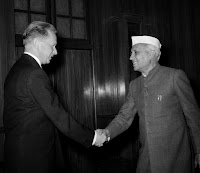But the only indigenous population The Chagos, which lies in the southern part of the Lakshadvipa Archipelago in the Sub-Continent of India, had was the Indian population hailing from the rest of the Lakshadvipa archipelago which also includes the Maldives, Sri Lanka and the mainland part of India. The
earliest settlement was only established in the Chagos Archipelago in 1793, until when the Island was mostly unpopulated but for the Indians residing there and the islands were predominantly uninhabited when first visited by European explorers, and remained that way until the French successfully established a small colony on the island of Diego Garcia, composed of 50–60 men and "a complement of slaves". The slaves came from what are now Mozambique and Madagascar via Mauritius. Thus, the original Chagossian colony established since 1793 comprised a mixture of the indigenous Indian people and the Bantu and Austronesian peoples! In addition, from 1820–1840, the atoll of Diego Garcia in the Chagos became the staging post for slave ships trading between Sumatra, the Seychelles, and the French island of Bourbon, adding a population of Malay slaves into the Chagos gene pool. Other than the Indian people, none of the peoples who were settled in the Chagos, be they from Mozambique, Madagascar, Sumatra, the Seychelles, or the island of Bourbon can claim the status to be indigenous or aboriginals in The Chagos archipelago. Surely, Tam Dalyell, British Member of Parliament should know of the ambit and scope of the meaning of the term “indigenous”! The Chagos archipelago is historically part of the Lakshadvipa archipelago in India and is historically an inalienable part of India and thus the People of the Chagos archipelago are thus ipso facto citizens of the Republic of India and the Government of India should demand the return of the archipelago back to India. The Chagos Archipelago has nothing to do whatsoever neither with Mauritius nor the Seychelles and islands are geographically, historically and culturally part of the Lakshadvipa archipelago in India. The Chagos Archipelago is geographically a part of the so-called Chagos - Lakshadweep Ridge, a long submarine mountain range in the Indian Ocean. The Chagos also form a terrestrial eco-region together with the Maldives and the Lakshadweep.
earliest settlement was only established in the Chagos Archipelago in 1793, until when the Island was mostly unpopulated but for the Indians residing there and the islands were predominantly uninhabited when first visited by European explorers, and remained that way until the French successfully established a small colony on the island of Diego Garcia, composed of 50–60 men and "a complement of slaves". The slaves came from what are now Mozambique and Madagascar via Mauritius. Thus, the original Chagossian colony established since 1793 comprised a mixture of the indigenous Indian people and the Bantu and Austronesian peoples! In addition, from 1820–1840, the atoll of Diego Garcia in the Chagos became the staging post for slave ships trading between Sumatra, the Seychelles, and the French island of Bourbon, adding a population of Malay slaves into the Chagos gene pool. Other than the Indian people, none of the peoples who were settled in the Chagos, be they from Mozambique, Madagascar, Sumatra, the Seychelles, or the island of Bourbon can claim the status to be indigenous or aboriginals in The Chagos archipelago. Surely, Tam Dalyell, British Member of Parliament should know of the ambit and scope of the meaning of the term “indigenous”! The Chagos archipelago is historically part of the Lakshadvipa archipelago in India and is historically an inalienable part of India and thus the People of the Chagos archipelago are thus ipso facto citizens of the Republic of India and the Government of India should demand the return of the archipelago back to India. The Chagos Archipelago has nothing to do whatsoever neither with Mauritius nor the Seychelles and islands are geographically, historically and culturally part of the Lakshadvipa archipelago in India. The Chagos Archipelago is geographically a part of the so-called Chagos - Lakshadweep Ridge, a long submarine mountain range in the Indian Ocean. The Chagos also form a terrestrial eco-region together with the Maldives and the Lakshadweep.
The façade about the sovereignty of Mauritius over the Chagos Archipelago was deliberately concocted in consonance with the diabolical game plan of the Government of Britain to obfuscate and suppress in order to divert and hijack the fact that the Chagos Archipelago is historically and geographically an integral part of India and in order to undermine and subvert the fact that the Chagos Archipelago is per se historically an inalienable part of India. India should not play into the hands of the Government of the U.K when they deceitfully and fraudulently seek India's help in resolving the issue of The Chagos. Here is a Government which is blatantly continually violating all canons of International law and not permitting and allowing the displaced people of Chagos to return back to their homeland in the Chagos Archipelago! India should in no uncertain terms tell the British Government in their face that India would help the British Government in resolving the issue of Chagos by making them unconditionally return and restore the Chagos Archipelago to the possession, control and sovereignty of India. The islands were called by their various names in Indian languages viz. Foalhavahi(ފޯޅަވަހި) and Feyhandheebu in Dhivehi, as Phehandweep (फेहंद्वीप) in Hindi and other northern Indian languages, and as Paeikaana Theevukal பேகான தீவுகள் in Tamil and were historically part of Indian kingdoms. It is inevitable that the sovereignty of the Chagos archipelago will be restored to India and the people of the Chagos archipelago whose ancestry substantially also goes back to the mainland part of India are, were and will be citizens of the Republic of India.







